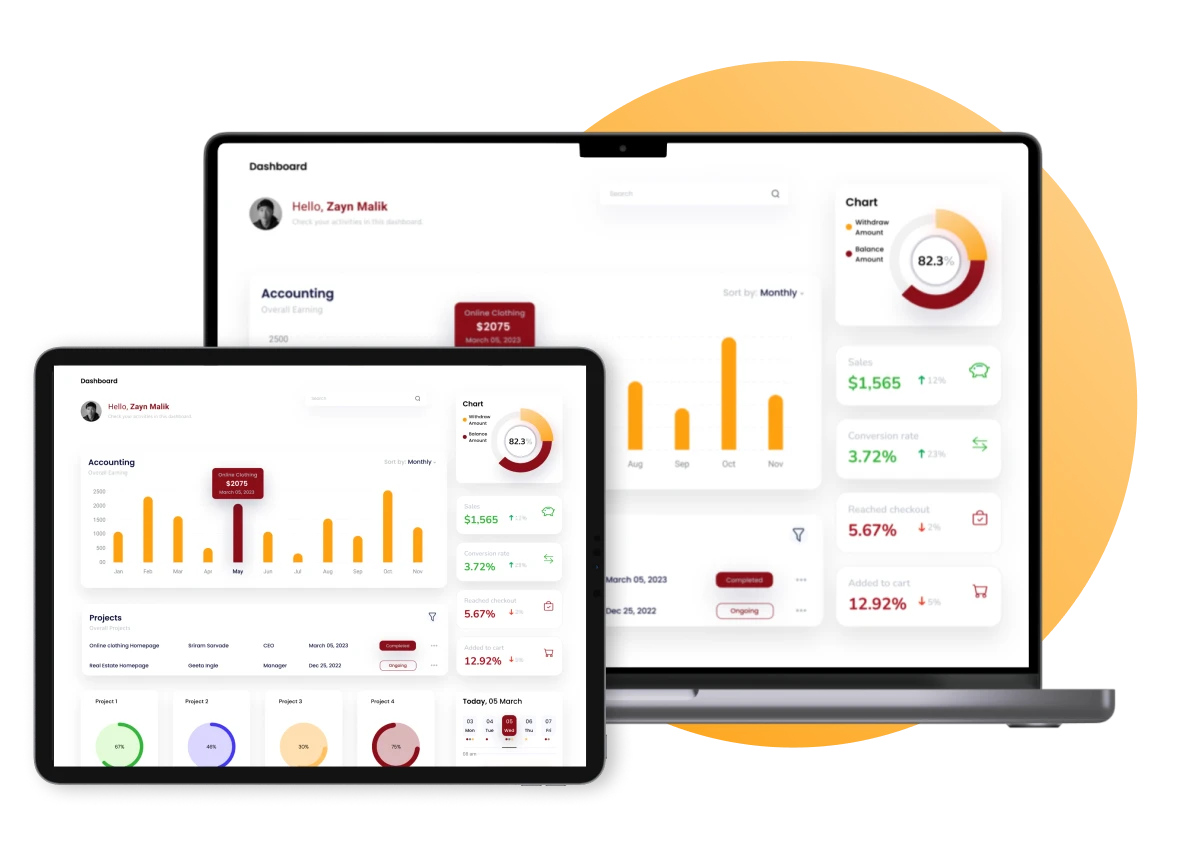Have you ever felt overwhelmed by ang gulo ng hindi na-manage na financial data within your business? Many Filipino enterprises face significant challenges due to a lack of comprehensive software for controlling their financial statements—such as cash flow, income statements, and balance sheets.
This gap in financial management can lead to missed opportunities, financial errors, and strategic missteps, leaving business owners in the dark about their company’s fiscal health. Read on to discover how to fix it!
Key Takeaways
|
Table of Content
Content Lists

What is Financial Data?

Financial data encompasses all the numerical records that illustrate a company’s financial activities. It is primarily sourced from three essential documents: the cash flow statement, the income statement, and the balance sheet. Each document offers unique insights into different aspects of business health.
The cash flow statement tracks cash movements, reflecting a company’s liquidity and operational sustainability. Moreover, the income statement summarizes revenues, costs, and expenses to reveal profitability. The balance sheet provides a snapshot of a company’s assets, liabilities, and shareholder equity.
This document is crucial for assessing a company’s financial stability and capability to meet long-term obligations. Understanding the financial report is also vital for maintaining financial control, making informed decisions, and strategizing based on accurate financial forecasts.
Differences Between Each Financial Data Records
| Financial Statement | Cash Flow Statement | Income Statement | Balance Sheet |
|---|---|---|---|
| Purpose | Tracks the flow of cash in and out of the business. | Summarizes revenues, costs, and expenses over a period. | Provides a snapshot of the company’s financial position at a specific point in time. |
| Components | Cash from operating activities, investing activities, and financing activities. | Revenue, expenses, gross profit, operating profit, net profit. | Assets, liabilities, shareholder equity. |
| Insights | Highlights liquidity and the company’s ability to sustain operations. | Provides insight into profitability and operational efficiency. | Shows financial stability and capacity to meet long-term obligations. |
Types of Financial Data
When it comes to understanding a business’s financial landscape, financial data or financial statements can be broadly categorized into two main types: traditional and alternative data. Each type provides unique insights and is crucial for thorough financial analysis.
- Traditional Data is derived from essential financial documents such as cash flows, income, and expenses. This data helps stakeholders evaluate asset management, profit generation, and financial obligations, providing a clear view of economic stability.
- Alternative Data encompasses information not found in standard financial statements, including online activities, geolocation, and social media trends. It reveals hidden patterns and new investment opportunities that traditional data may overlook.
In summary, both traditional and alternative data play pivotal roles in a company’s financial assessment. Combined with comprehensive accounting software, they provide a multi-dimensional view of a company’s financial health and market position, enhancing decision-making processes for investors and management alike.
Managing Financial Data
Effective financial statement management is critical to ensuring a company’s compliance with financial regulations and improving overall financial performance. By implementing advanced accounting software Philippines, companies can streamline the collection, organization, and analysis of extensive financial information.
This technology supports accurate and timely reporting of financial activities, enabling informed decision-making and strategic planning. Sophisticated software solutions, including rebate solutions, facilitate real-time financial monitoring, which is essential for detecting discrepancies early to maintain financial health.
Using such technological systems in financial data management not only aids in adapting to market changes and managing associated risks but also ensures the integrity and security of financial data. With these tools, businesses can enhance their operational efficiency, minimize errors, and reduce the time spent on manual data processing.
Financial Data Examples
Financial data encompasses a wide range of information crucial for assessing a company’s financial health and making informed business decisions. Here are some common examples:
- Revenue and Sales Data: This includes total sales figures, revenue by product line or region, and year-over-year sales growth, providing insights into a business’s profitability and market reach.
- Expense Data: Key expense categories such as operational, administrative, marketing, and advertising costs are tracked to evaluate efficiency and cost management.
- Profit Figures: Data like gross, operating, and net profit help assess a company’s ability to generate earnings relative to its revenue and operating costs.
- Asset and Liability Information: This includes details on current and fixed assets, inventory levels, property, plant, and equipment values, and liabilities such as short-term and long-term debts and accounts payable.
- Equity Data: Information on shareholder equity, retained earnings, and stock figures provide insights into a company’s financial structure and investor commitment.
- Cash Flow Statements: Tracking operating, investing, and financing cash flows is vital for understanding the liquidity and cash management of the business.
- Investment Data: Insights into stock prices, dividends, bond yields, and mutual fund performance are crucial for investment strategies and portfolio management.
- Budgets and Forecasts: Annual and quarterly budgets, along with revenue, expense, and profit projections, are essential for strategic planning and resource allocation.
- Tax Records: Details of tax liabilities, deductions, credits, and returns are necessary for compliance and financial planning.
- Credit Information: Credit scores, history, debt-to-income ratios, and credit usage rates are significant for assessing creditworthiness and financial stability.
- Market Data: Information on market trends, economic indicators, and sector performance aids in macroeconomic analysis and strategic alignment.
These examples highlight how diverse financial data can be and underscore its importance in various analytical and strategic contexts within a business. Furthermore, using financial reporting software, this data is often visualized in financial dashboards or detailed in reports like balance sheets, income statements, and cash flow statements, providing a comprehensive view of a company’s financial standing.
Also read: Restaurant Accounting: A Guide to Master the Basics
Manage Financial Data with HashMicro’s Accounting Software

Managing financial data efficiently is crucial for any business aiming to enhance performance, ensure accuracy, and streamline operations. Because of this, HashMicro’s accounting software is designed to address these needs with powerful features that automate and optimize financial tasks.
- Bank Integrations: Automates the reconciliation of bank statements and payment management, ensuring accuracy and timeliness. Eliminating manual data entry reduces errors and saves time.
- Multi-Level Analytical Tools: This feature compares financial statements across different projects or branches, providing deep insights into business segments. It facilitates the identification of performance trends, supporting informed strategic decisions.
- Profit & Loss vs. Budget & Forecast: This feature enables direct comparisons between actual financial results and budget forecasts. It helps businesses accurately monitor their financial health and swiftly adjust strategies to meet financial goals.
- Complete Financial Statements with Period Comparison: This allows for the creation of detailed financial statements with comparisons over different periods. It is essential for businesses aiming to track financial progress and strategically plan for the future.
Each feature of our software refines financial statement management and positions businesses to master their financial domain comprehensively. By choosing HashMicro, companies leverage superior tools that enhance decision-making precision. With us, you don’t just keep pace; you lead with innovation and strategic insight.
Conclusion
Managing financial data is pivotal for any business striving for growth and sustainability. HashMicro’s accounting software offers robust tools integrating traditional and alternative financial statements. This integration ensures that businesses can make informed decisions and maintain compliance with financial regulations.
Businesses can streamline financial processes by utilizing HashMicro’s accounting solutions. The system offers features like auto-reconciliation and advanced reporting to support better decision-making. Finally, enhance your financial operations and strategic decisions by exploring our software with a free demo today!
Frequently Asked Questions
-
What is financial data called?
Financial statement is often referred to as financial information or financial records. Besides, this record encompasses all numerical details about a company’s fiscal activities.
-
How important is financial data?
Financial data is crucial for decision-making, enabling businesses to track performance, plan strategically, and ensure compliance.
-
What are the basic financial data?
The basic financial statement includes balance sheets, income statements, and cash flow statements. This provides insights into a company’s financial health, profitability, and liquidity.





































